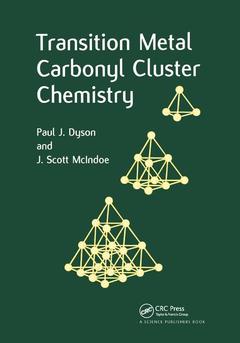Description
Transition Metal Carbonyl Cluster Chemistry
Authors: Dyson Paul J., McIndoe J. Scott
Language: English
Subject for Transition Metal Carbonyl Cluster Chemistry:
Keywords
Transition Metal Carbonyl Cluster; Ru Ru Bond; Transition Metal; Metal Metal Bond; Carbonyl Ligand; High Nuclearity Clusters; Hydride Ligands; NMR Spectroscopy; Carbonyl Cluster; Mixed Metal Cluster; Trigonal Bipyramid; Total Electron Count; Transition Metal Clusters; Fe Fe Bond; Octahedral Cluster; Cyclopentadienyl Ligands; Trigonal Prism; Osmium Atoms; HOMO-LUMO Gap; Solid State NMR Spectroscopy; Frontier Orbitals; Bonding Modes; NMR Timescale; Electron Count; Nitrosyl Ligands
Approximative price 74.82 €
In Print (Delivery period: 14 days).
Add to cartPublication date: 09-2019
· 17.8x25.4 cm · Paperback
Approximative price 208.65 €
Subject to availability at the publisher.
Add to cartPublication date: 11-2000
180 p. · 17.8x25.4 cm · Hardback
Description
/li>Contents
/li>Readership
/li>Biography
/li>
Transition metal carbonyl clusters (TMCCs) continue to inspire great interest in chemical research, as much for their fascinating structures as for potential industrial applications conferred by their unique properties. This highly accessible book introduces the bonding, structure, spectroscopic properties, and characterization of clusters, and then explores their synthesis, reactivity, reaction mechanisms and use in organic synthesis and catalysis.
Transition Metal Carbonyl Cluster Chemistry describes models and rules that correlate cluster structure with electron count, which are then applied in worked examples. Subsequent chapters explain how bonding relates to molecular structure, demonstrate the use of spectroscopic techniques such as NMR, IR and MS in
cluster chemistry, and outline the factors contributing to the stability, dynamics and reactivity of clusters. The second part of this book discusses the synthesis and applications of TMCCs. It emphasizes the differences between the reactivities of clusters vs. mononuclear metal complexes, contingent to the availability of multiple-bonding sites and heterosite reactivity. The final chapters discuss reactions in which clusters act as homogeneous catalysts; including discussion on the use of solid and biphasic liquid-liquid supported clusters in heterogeneous catalysts.
A useful reference for those commencing further research or post-graduate study on metal carbonyl clusters and advanced organometallic chemistry, this book is also a cornerstone addition to academic and libraries as well as private collections.
These books may interest you

Gas Phase Inorganic Chemistry 52.74 €



